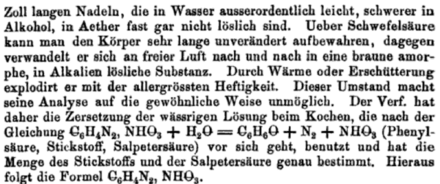Diazoaminobenzene
| Structural formula | |||||||||||||||||||
|---|---|---|---|---|---|---|---|---|---|---|---|---|---|---|---|---|---|---|---|

|
|||||||||||||||||||
| ( E ) isomer | |||||||||||||||||||
| General | |||||||||||||||||||
| Surname | Diazoaminobenzene | ||||||||||||||||||
| other names |
|
||||||||||||||||||
| Molecular formula | C 12 H 11 N 3 | ||||||||||||||||||
| Brief description |
yellow-brown solid |
||||||||||||||||||
| External identifiers / databases | |||||||||||||||||||
|
|||||||||||||||||||
| properties | |||||||||||||||||||
| Molar mass | 197.24 g · mol -1 | ||||||||||||||||||
| Physical state |
firmly |
||||||||||||||||||
| Melting point |
92-95 ° C |
||||||||||||||||||
| boiling point |
146 ° C |
||||||||||||||||||
| solubility |
|
||||||||||||||||||
| safety instructions | |||||||||||||||||||
|
|||||||||||||||||||
| As far as possible and customary, SI units are used. Unless otherwise noted, the data given apply to standard conditions . | |||||||||||||||||||
Diazoaminobenzene is a triazene substituted with two phenyl groups . It is an isomer of aniline yellow , and if unsuitable reaction conditions are selected ( pH and temperature for the azo coupling ), it is formed instead.
history
In 1860 Peter Griess described a substance that he obtained from the action of nitrous acid on an alcoholic aniline solution. In 1863 he published a method to obtain this substance by introducing nitrous gases into an ethanolic solution of "nitric acid aniline" (salt of nitric acid and aniline) until needle-shaped "crystals" separate. More detailed descriptions of the experiments can be found in the publication "About a new class of organic compounds in which hydrogen is represented by nitrogen". Here he reports that the compound is formed in the form of white crystals that are readily soluble in water but not in ether or alcohol. However, he also reports that the connection explodes violently due to heat or vibration. This is the first indication of the synthesis of 1,3-diphenyltriazene.
Extraction and presentation
Diazoaminobenzene is produced by diazotizing aniline and coupling to undiazotized aniline at pH values> 9.
properties
Diazoaminobenzene is a yellow-brown, finely crystalline powder. It is sensitive to light, impact, friction and impact (risk of explosion). When heated above the boiling point and when exposed to light, it splits off nitrogen. Specifically, an uncontrolled, explosive decomposition is to be expected here. The heat of decomposition determined by DSC is −266 kJ mol −1 or −1348 kJ kg −1 . When exposed to acids, it rearranges into 4-aminoazobenzene ( aniline yellow ).
Chemical properties
Triazenes can tautomerize; in the case of diazoaminobenzene, the two tautomeric forms are identical. The –N = N – double bond shows the usual ( EZ ) isomerism . The more stable isomer is ( E ) -diazoaminobenzene; no data have been found in the literature on the less stable ( Z ) -diazoaminobenzene.
use
Diazoaminobenzene is / was used as an insecticide and as a plastic additive. In organometallic chemistry it is used as a ligand (= complexing agent). It occurs as an impurity in dyes, cosmetics and pharmaceuticals.
safety instructions
Diazoaminobenzene is suspected of being carcinogenic . It is metabolized in the body to form the substances benzene and aniline, which are classified as carcinogenic . It also shows mutagenic properties.
proof
The detection can take place by means of thin layer chromatography or by HPLC .
Individual evidence
- ↑ a b c d data sheet diazoaminobenzene (PDF) from Merck , accessed on January 18, 2011.
- ↑ Entry on diazoaminobenzene in the ChemIDplus database of the United States National Library of Medicine (NLM) .
- ↑ Entry on 1,3-diphenyltriazene. In: Römpp Online . Georg Thieme Verlag, accessed on September 16, 2011.
- ↑ a b Datasheet 1,3-Diphenyltriazenes from Sigma-Aldrich , accessed on May 23, 2017 ( PDF ).
- ^ P. Griess: Annalen der Chemie und Pharmacie CXIII (1860). P. 337.
- ↑ P. Griess: Centralblatt (1863). P. 125.
- ↑ P. Griess: Centralblatt No. 7 11th year (1866). P. 1.
- ↑ Hartman, WW; Dickey, JB: Diazoaminobenzene In: Organic Syntheses . 14, 1934, p. 24, doi : 10.15227 / orgsyn.014.0024 ; Coll. Vol. 2, 1943, p. 163 ( PDF ).
- ↑ Grewer, T .; Klais, O .: Exothermic decomposition - investigations of the characteristic material properties , VDI-Verlag, series "Humanisierung des Arbeitsleben", Volume 84, Düsseldorf 1988, ISBN 3-18-400855-X , p. 9.
- ^ Entry on 1,3-diphenyl-1-triazenes in the Hazardous Substances Data Bank , accessed on November 18, 2014.
- ↑ a b National Institute of Environmental Health Sciences , 13th Report on Carcinogens (RoC): Diazoaminobenzene , accessed November 18, 2014.
literature
- Helv. Chim. Acta . 63, 1980, pp. 456-472
- Beilstein . EIV 16, p. 904
- Helv. Chim. Acta . 64, 1981, pp. 174-175
- Merck Index (10), No. 2970
- Ullmann . 5, p. 802

